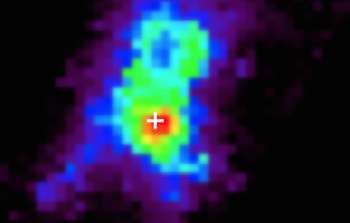sci14019 — Announcement
Extreme Star Formation (and a Galaxy Cluster's Violent Environment)
March 20, 2014
The high star formation rate of the central galaxy of the Phoenix cluster (around 800 MSun/year) is fed by the flow of cold, dense gas in the cluster. Evidence for shocks, an active galactic nucleus, and the outflow of ionized material appear in new observations obtained using the integral field unit of the Gemini Multi-Object Spectrograph at Gemini South. The total luminosity in Hα alone approaches 1044 erg/second, and the large velocity dispersion (variations in the velocities of material) suggests a turbulent environment. The current observed rate of star formation cannot be sustained, considering the mass of the reservoir of cold gas available to form stars. The authors of the new work, led by Michael McDonald (Massachusetts Institute of Technology), suggest that the probability of observing another similar short-lived intense phase of activity in any cluster is less than 1%. Complete results are published in The Astrophysical Journal.
About the Announcement
| Id: |
ID
sci14019
|
